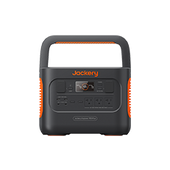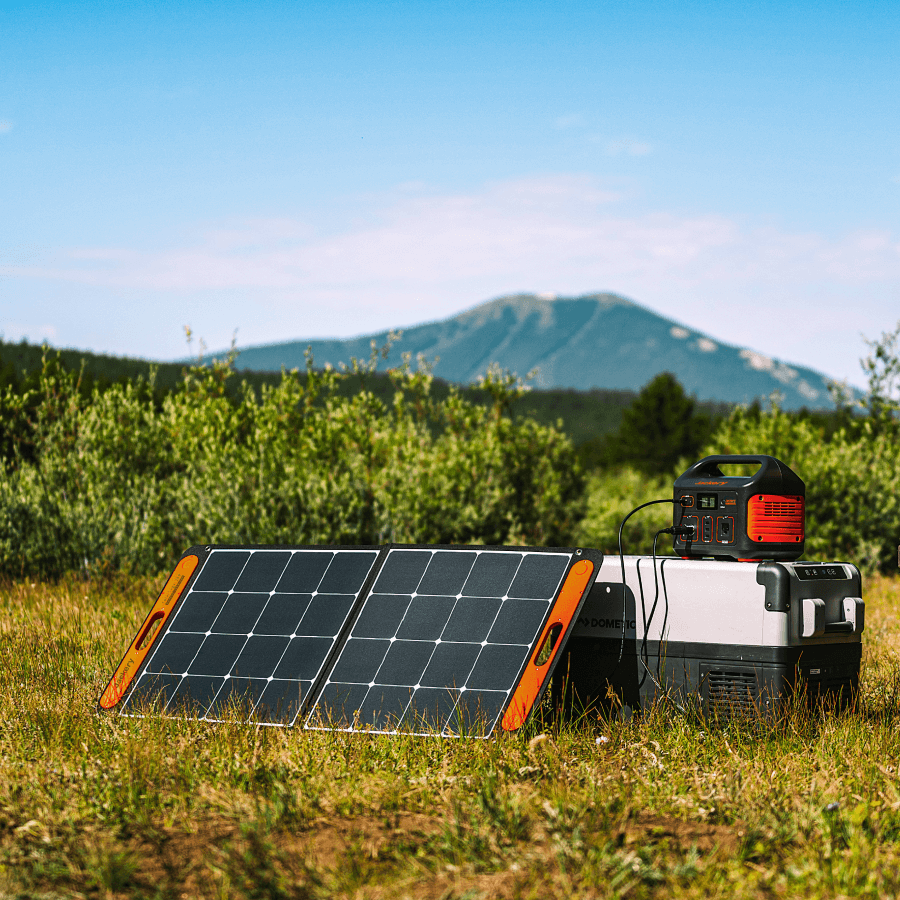Tiny houses are becoming widely popular among people looking to cut down their expenses and reduce the environmental impact. However, before you move from traditional homes to tiny houses, you'll need to figure out one important thing — power. Since small homes typically exist off-grid, the best way to power them is by using solar panels for tiny houses.
The number of solar panels you'll need for your tiny house will depend on how many appliances you use. Jackery offers a wide range of high-quality solar panels compatible with power stations. Jackery Solar Generator 3000 Pro combines Explorer 3000 Pro Portable Power Station and SolarSaga 200W Solar Panels to charge 99% of appliances at home.
What Are the Benefits of Solar Panels for Tiny Houses?
Going solar offers many benefits, like reduced utility bills, lower environmental impact, and more. Additionally, solar energy is widely available, making it a free and renewable energy source for tiny houses. Here are a few main benefits of using solar panels for tiny homes.
- Solar power for tiny houses helps you to save costs by reducing utility bills.
- Using free and renewable solar energy enables you to live in an eco-friendly way and save the planet.
- Going off the grid reduces your worries about blackouts, brownouts, and power outages. You can power your appliances even if the grid is down.
What Are the Drawbacks of Solar Panels for Tiny Houses?
While solar panels for tiny houses come with a bunch of advantages, there are a few drawbacks you must know.
- You'll need to spend thousands of dollars to buy a solar panel system.
- The additional lithium-ion or LiFePO4 batteries can store the charge from solar panels but are expensive.
- Tiny houses are small, and installing large solar panels on the roof might not be ideal. That's why it's better to buy compact and portable solar panels with batteries.
In this table, let's quickly wrap up the pros and cons of solar panel systems for tiny houses.
|
Pros |
Cons |
|
● Saving electric bills ● Reduces environmental impact ● Eliminates dependency on grid electricity |
● High upfront cost ● Require expensive additional batteries |
What to Consider When Choosing Solar Panels for Tiny House?
You can install solar power panels on the roof of your tiny home or choose a portable battery backup to charge appliances. However, with a lot of solar panels available, it can be challenging to choose the one that meets your power requirements and budget. Therefore, it's ideal to consider a few important factors before you shell out money.
Power Usage
When choosing the solar panels for a tiny house, you'll need to know how many watts you use per hour or day. For instance, you'll need more solar panels and a larger battery capacity if you have higher power needs. If you have a high power requirement, consider Jackery SolarSaga 200W Solar Panels with an Explorer 3000 Pro Portable Power Station.
Types of Solar Panels
Mainly, three types of solar panels are available — monocrystalline, polycrystalline, and thin-film. Monocrystalline solar power panels are the most efficient type made with single silicon cells, whereas polycrystalline are less efficient panels built with different silicon cells. Thin-film solar power panels are the least efficient type but have low cost.
Cost
The solar panels for tiny houses cost varies from a few hundred to thousands of dollars, depending on the quality. When buying solar panels, you must ensure they fall within your budget. Although monocrystalline solar panels have a higher initial cost, they are sturdy and have the highest quality.
Location
Southwestern states like Arizona, Florida, etc., generally get more sunshine hours as they are located in the sunbelt. However, if your tiny home is in the Northern Hemisphere, tilt the panels to the true south to get direct sunlight. The southern hemisphere should tilt PVs towards the true North. You must ensure the sun's rays hit the solar panels perpendicularly throughout the day for best results.

How Much Solar Power Needed for a Tiny House?
The first step to choosing the right solar power system is determining how much electricity you need. In order to calculate the exact energy consumption, all you need to do is list all the appliances and see how much energy they consume daily.
Energy consumption of an appliance = Watts × Usage time
Suppose you have a mini refrigerator that consumes 200 watts of energy. If you run the fridge for 5 hours, you'll need a solar system that supplies 200W*5H = 1000Wh.
The below table reveals the power consumption of daily household appliances and their usage time.
|
Item |
Watts |
Usage Time (in hours) |
Energy in Watt-hours |
|
5 Led lights |
5 |
5 |
125 |
|
Incandescent lighting |
60 |
5 |
300 |
|
Refrigerator |
200 |
8 |
1600 |
|
AC unit |
1000 |
5 |
5000 |
|
Cellphone |
5 |
5 |
25 |
|
Well pump |
750 |
1 |
750 |
|
Space heater |
1000 |
4 |
4000 |
If you wish to power your tiny home with solar energy, it's better to invest in the Jackery Solar Generator, which combines a portable power station and solar panels. The solar panels convert solar energy into DC electricity, and the pure sine wave inverter in the portable power station then converts DC to AC electricity to charge the appliances. Below, we will recommend two Jackery Solar Generators for tiny homes that can charge most household appliances for long hours.
Jackery Solar Generator 2000 Plus
The Jackery Solar Generator 2000 Plus is one of the large-capacity generators that can charge 99% of tiny home appliances for long hours. You can connect the solar generator to the home's electricity system to switch from utility grid power to battery backup in just 20ms. By adding multiple battery packs, you can expand the battery capacity all the way to 24kWh and ensure home appliances remain powered during long-term power outages.
Customer Review
“Easy to set up and use, thoughtful design to have a battery mounted on wheels. Since this is a modular system, we will be adding more components in the future.” — Denise Shepherd.
Jackery Solar Generator 5000 Plus
The Jackery Solar Generator 5000 Plus is the most trusted whole-home backup power that can charge almost all household appliances for long hours. Its dual voltage support ensures you can charge appliances working at 120V or 240V. It features an optimized CTB structure equipped with a pull handle, and double wheels ensure easy movement from one spot to another. It supports add-on battery packs to extend the capacity from 5kWh to 60kWh, ensuring a long-lasting power supply to tiny home appliances.
Customer Review
“Incredible whole home set-up! Easy installation (per the electrician) and very versatile. I look forward to adding more power for a longer backup. Great job Jackery!” — Customer.
|
Products |
Capacity |
Recharging Time |
Appliances Running Time |
|
Jackery Solar Generator 2000 Plus |
2042.8Wh |
Solar Panels = 2H (6*Jackery SolarSaga 200W Solar Panels) Car Charging = 25H Wall Outlet = 2H |
Refrigerator (200W) = 8.1H Lights (5W) = 326.8H AC Unit (1000W) = 1.6H Space Heater (1000W) = 1.6H TV (150W) = 32.6H CPAP (40W) = 40.8H |
|
Jackery Solar Generator 5000 Plus |
5040Wh |
AC Charging = 3.5H Charging via Smart Transfer Switch = 1.7H Solar Charging = 6.5H (2*Jackery SolarSaga 500X Solar Panels) High-voltage PV charging = 1.7H Hybrid Charging (AC, Solar Panels, and Smart Transfer Switch): 1.7H |
Refrigerator (200W) = 20.1H Lights (5W) = 806.4H AC Unit (1000W) = 4.0H Space Heater (1000W) = 4.0H TV (150W) = 26.8H CPAP (40W) = 100.8H |
Please note that all the calculations are just for reference purposes and might vary from actual runtime.
How to DIY Solar Panels for Tiny House?
If you want to build a DIY solar panel system for tiny houses, here are the main components you must know.
Solar Panels: First, you'll need multiple solar panels to charge the battery backup system. You can choose roof-mounted panels fixed atop your house roof or portable and foldable solar panels. If you don't have enough roof space, it is better to choose portable solar panels.
Battery Backup: You must invest in a safe and large-capacity battery backup. The two best batteries that can charge faster and supply stable electricity to appliances are lithium-ion and LiFePO4. Although these batteries have a high upfront cost, they last long and are relatively sturdy.
Inverter: The inverter takes power in the form of DC from the solar power panels and converts it to AC electricity that safely charges appliances.
Charge Controller: The primary role of the charge controller is to manage the power supplied to batteries.
Many new technology batteries come with an in-built MPPT charge controller and inverter to reduce the complete installation cost.
Now that we have covered the components of a solar panel system, here is how it works.
The PV or solar panels convert the sun's rays to electric energy (DC electricity), which is then supplied to the inverter. It converts DC current to AC electricity, which then flows to charge your tiny home appliances.
The cost of solar power panels for tiny homes will vary depending on the power output and the number of components. If you are investing in a roof-mounted solar panel system, you'll have to pay for high installation costs.
However, that's not the case when you choose portable solar systems like Jackery Solar Generators. They combine Jackery Explorer Portable Power Stations and SolarSaga Solar Panels to efficiently power most tiny home appliances.
The battery backups are made with lithium-ion or LiFePO4 batteries to safely charge appliances for long hours. These battery backups have a built-in inverter to supply safe electricity and ensure no power fluctuations while charging devices. The MPPT charger controller provides 99% solar charging efficiency.
Final Thoughts
Buying portable power stations and solar panels for tiny houses is a wise decision to power most appliances for long hours. Not only will this help you charge electrical devices faster, but it will also lower the environmental impact by reducing the emission of harmful gases.
You can combine Jackery SolarSaga Solar Panels with the Explorer Portable Power Stations to power all your home devices. For instance, the Jackery Solar Generator 3000 Pro is designed to charge 99% of tiny home appliances, making it a smart choice for homeowners.












































































































![Solar Panels for Tiny House [Ultimate Guide 2025]](http://www.jackery.com/cdn/shop/articles/solar_panels_for_tiny_houses_d352e3a5-a877-41ea-b2fd-133dd7402e73.jpg?v=1738837420)







Leave a comment